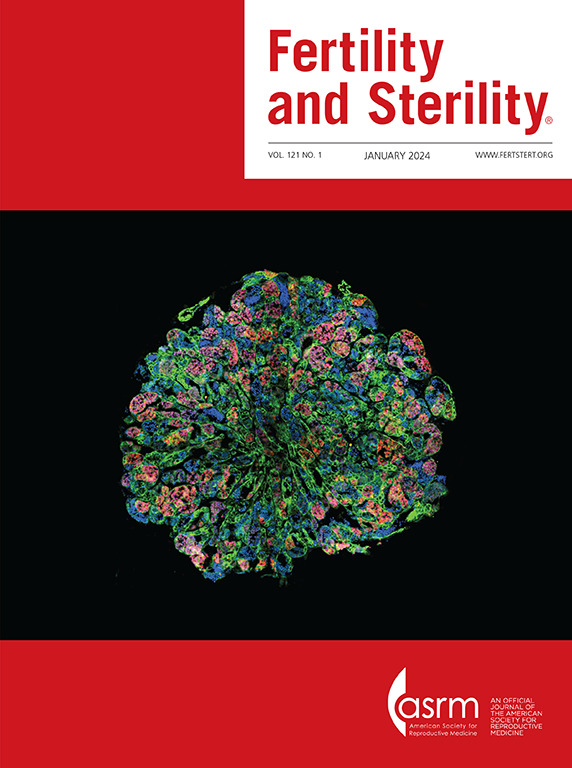双触发与gnrh -选择性生育保留的触发。一项随机对照试验。
IF 7
1区 医学
Q1 OBSTETRICS & GYNECOLOGY
引用次数: 0
摘要
摘要目的:本研究旨在比较双触发与单激动剂在选择性保留生育能力的预后良好患者中成熟卵母细胞的疗效。随机、对照、单中心、优势临床试验受试者:在2021年10月至2023年4月期间,共有109名女性以1:1的比例入组该研究。符合条件的患者年龄≤40岁,卵泡计数<20,抗苗勒管激素≤3 ng/ml,进行选择性生育保存周期。干预:根据卵巢储备和体重,采用225-300IU/天促卵泡素α或β或15-20 μg促卵泡素δ刺激卵巢。通过黄体酮刺激卵巢方案抑制黄体生成素激增,从卵巢刺激开始到触发日,口服微量黄体酮(200mg /天)。一旦超声观察到至少3个≥18 mm的卵泡,将患者随机分为干预组(Triptorelin 0.2 mg + 250 mcg rhCG)或对照组(Triptorelin 0.2 mg)。主要结局指标:主要终点是选择保留生育能力的患者在双触发和GnRH-a触发的最终卵母细胞成熟后获得的MII卵母细胞数量。结果共对109例患者进行了分析,其中双触发组55例,对照组54例。双触发组和GnRH-a组的总卵母细胞数和MII卵母细胞数(EMD分别为9.22±5.11vs.9.56±5.16,EMD分别为0.34 [95%CI: -2.29;1.61])和7.31±4.63vs.7.94±4.39 (EMD分别为-0.64 [95%CI: -2.07;0.80])差异无统计学意义。同样,在触发后的第二天,雌二醇、黄体酮、黄体生成素和卵泡刺激素水平也没有统计学上的显著差异。值得注意的是,两组均未出现卵巢过度刺激综合征(OHSS)。结论在保留生育能力的患者中,在GnRH-a中加入hCG触发最终卵母细胞成熟并不优于单独使用GnRH-a。因此,触发方式的选择应根据患者和临床医生的喜好,以患者的安全性和便利性为重点。试验注册号:04992468。本文章由计算机程序翻译,如有差异,请以英文原文为准。
Dual trigger versus GnRH-a trigger for elective fertility preservation. A randomized controlled trial.
Structured Abstract OBJECTIVE: The study aims to compare the efficacy, in terms of mature oocytes, of dual trigger vs. agonist alone in good prognosis patients undergoing elective fertility preservation.
DESIGN
Randomized, controlled, single-center, superiority clinical trial SUBJECTS: A total of 109 women were enrolled in this study between October 2021 and April 2023 with a 1:1 allocation. Eligible patients were ≤40 years old, with an antral follicular count <20 and anti-Mullerian hormone ≤3 ng/ml undergoing elective fertility preservation cycles.
INTERVENTION
Controlled ovarian stimulation was performed using 225-300IU/day of follitropin alfa or beta or 15-20 μg of follitropin delta, tailored to ovarian reserve and weight. LH surge was suppressed through a progestin-primed ovarian stimulation protocol, with oral administration of micronized progesterone (200mg daily) from the beginning of ovarian stimulation until the trigger day. As soon as at least three follicles ≥ 18 mm were observed by ultrasound, patients were randomization to the intervention group (Triptorelin 0.2 mg + 250 mcg rhCG) or the control group trigger with GnRH-a alone (Triptorelin 0,2 mg).
MAIN OUTCOME MEASURES
The primary endpoint was the number of MII oocytes retrieved after final oocyte maturation with dual trigger and GnRH-a trigger in patients undergoing elective fertility preservation.
RESULTS
Overall, 109 patients were analyzed, 55 in the Dual trigger group and 54 in the control arm (GnRH-a). No statistically significant differences were found regarding the total number of oocytes nor MII oocytes retrieved between the Dual Trigger and GnRH-a groups (9.22 ± 5.11vs.9.56 ± 5.16, (EMD-0.34 [95%CI: -2.29;1.61]) and 7.31 ± 4.63vs.7.94 ± 4.39 group (EMD -0.64 [95%CI: -2.07;0.80], respectively). Likewise, no statistically significant differences were found regarding estradiol, progesterone, LH and FSH levels on the day following the trigger. Notably, neither group exhibited any case of Ovarian Hyperstimulation Syndrome (OHSS).
CONCLUSION
In patients undergoing fertility preservation, adding hCG to GnRH-a for triggering final oocyte maturation is not superior to the administration of GnRH-a alone in terms of MII oocytes. Therefore, the selection of the trigger method should be based on both patients' and clinicians' preferences, with a focus on patients' safety and convenience.
TRIAL REGISTRATION NUMBER
NCT04992468.
求助全文
通过发布文献求助,成功后即可免费获取论文全文。
去求助
来源期刊

Fertility and sterility
医学-妇产科学
CiteScore
11.30
自引率
6.00%
发文量
1446
审稿时长
31 days
期刊介绍:
Fertility and Sterility® is an international journal for obstetricians, gynecologists, reproductive endocrinologists, urologists, basic scientists and others who treat and investigate problems of infertility and human reproductive disorders. The journal publishes juried original scientific articles in clinical and laboratory research relevant to reproductive endocrinology, urology, andrology, physiology, immunology, genetics, contraception, and menopause. Fertility and Sterility® encourages and supports meaningful basic and clinical research, and facilitates and promotes excellence in professional education, in the field of reproductive medicine.
 求助内容:
求助内容: 应助结果提醒方式:
应助结果提醒方式:


